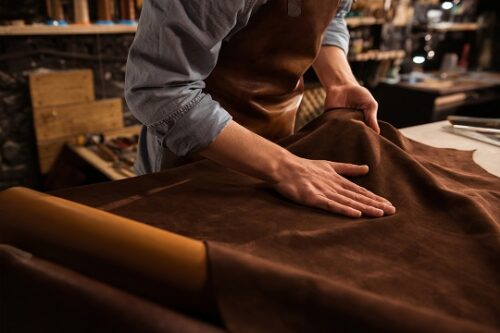4 January 2023
An article co-authored by Mallika Sharma on WikiHow sets out some simple ways how to tell real leather from fake leather in garments. It can be more tricky to tell the difference in automotive leather because it is designed specifically to minimise variance and many automotive companies specify leather that doesn’t have that smell we associate with genuine leather. Below is a quick summary by One4Leather.

1. Give it a sniff
One of the best things about leather is its glorious aroma. It’s probably the hardest thing for fakers to fake so this is a good starting point.
2. Read the label!
Naturally, if the maker of the article has used genuine leather he will want to tell you. So if there’s no label, it may be fair to conclude he has something to hide. Beware also of false or misleading labelling. Designations such as ‘vegan leather’ or ‘faux leather’ or ‘leatherette’ are not leather at all. Some countries have banned this kind of misleading information but we still await a blanket EU ban. Even the terms ‘genuine’ or ‘real’ leather can cause confusion and we have published articles before on what genuine leather actually is.
3. Get a feel for it
With its textured surface, genuine leather feels soft and flexible. Fake leather will probably be smooth and somewhat hard or ‘plasticky’. Genuine leather has a warmth to it compared to the coolness of plastic and it can be stretched a little.
4. Check for imperfections
As leather is a 100% natural and organic material, no two pieces are the same. Each piece of leather is like its own fingerprint. If you can compare your piece of ‘leather’ with another you’ll see that they are unique if genuine. If fake, they will look identical. Genuine leather hides will also have natural imperfections. If your piece looks too good to be true, it probably is. In addition, try and check the edges of the leather. The genuine article will be coarse and fibrous whereas a synthetic material will have perfectly straight edges.
5. Try a little water
Genuine leather is water resistant but that does not mean it won’t absorb some water on its surface. Fake materials, on the other hand, will be impermeable to water and it will simply run-off. So sprinkle a few drops on the material you’re testing and see what happens.
One final point on how to tell if it’s real leather: leather is the result of a lot of craftsmanship and knowhow which is why it can seem expensive. We would say it is “reassuringly expensive” because it’s an indication that it’s the real deal and a reflection of the care and expertise that’s gone into its production. If the material you’re examining seems cheaper than you’d normally expect, it’s probably trying to pull the wool over your eyes. Put it down and step away!
We bring leather, material and fashion businesses together: an opportunity to meet and greet face to face. We bring them from all parts of the world so that they can find fresh partners, discover new customers or suppliers and keep ahead of industry developments.
We organise a number of trade exhibitions which focus on fashion and lifestyle: sectors that are constantly in flux, so visitors and exhibitors alike need to be constantly aware both of the changes around them and those forecast for coming seasons.